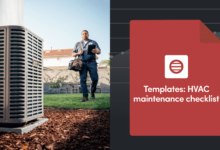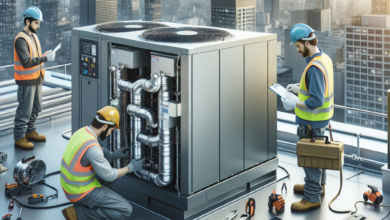Choosing the Right HVAC System for Your Home: Installation Considerations
HVAC System Installation – When it comes to creating a comfortable living environment, choosing the right HVAC (Heating, Ventilation, and Air Conditioning) system for your home is crucial. An efficient and properly installed HVAC system not only ensures optimal indoor temperature and air quality but also helps reduce energy consumption and utility costs. However, with a wide range of options available in the market, selecting the most suitable HVAC system can be a daunting task. In this article, we will explore the key installation considerations to help you make an informed decision.
1. Assessing Your Home’s Heating and Cooling Needs
Before diving into the world of HVAC systems, it is essential to assess your home’s heating and cooling needs. Factors such as the size of your home, insulation, number of windows, and local climate play a significant role in determining the appropriate HVAC system capacity. An undersized system may struggle to maintain the desired temperature, while an oversized system can lead to frequent cycling and inefficient operation.
Consider consulting with a professional HVAC contractor who can perform a load calculation to determine the heating and cooling requirements of your home accurately. This calculation takes into account various factors and helps you choose the right-sized HVAC system for optimal performance and energy efficiency.
2. Energy Efficiency Ratings
Energy efficiency is a crucial aspect to consider when selecting an HVAC system. Higher energy efficiency not only reduces your carbon footprint but also translates into significant cost savings over the system’s lifespan. Look for systems with high Seasonal Energy Efficiency Ratio (SEER) ratings for cooling and Annual Fuel Utilization Efficiency (AFUE) ratings for heating.
The SEER rating indicates the cooling efficiency of an air conditioner or heat pump, with higher ratings indicating better efficiency. Similarly, the AFUE rating measures the heating efficiency of a furnace, with higher ratings indicating less wasted energy. Opting for systems with ENERGY STAR certification ensures that they meet strict energy efficiency guidelines set by the Environmental Protection Agency (EPA).
3. Types of HVAC Systems
There are several types of HVAC systems available, each with its own advantages and considerations. Let’s explore some of the most common options:
3.1. Split Systems
Split systems are the most traditional and widely used HVAC systems. They consist of an outdoor unit (containing the condenser and compressor) and an indoor unit (containing the evaporator coil and blower). Split systems can be further categorized into:
- Single-stage systems: These systems operate at full capacity whenever they are running, providing a constant temperature.
- Two-stage systems: These systems have two levels of operation, allowing for more precise temperature control and increased energy efficiency.
- Variable-speed systems: These systems can adjust their capacity based on the heating or cooling demands, providing the highest level of comfort and energy efficiency.
3.2. Packaged Systems
Packaged systems are ideal for homes with limited indoor space. In these systems, all components (including the compressor, condenser, and evaporator) are housed in a single unit, usually installed on the roof or a concrete slab near the foundation. Packaged systems can be further classified into:
- Gas/electric systems: These systems use both gas and electricity for heating and cooling, providing flexibility and efficiency.
- Heat pump systems: These systems use electricity to provide both heating and cooling, making them a more energy-efficient option.
3.3. Ductless Mini-Split Systems
Ductless mini-split systems are an excellent choice for homes without existing ductwork. They consist of an outdoor unit connected to one or more indoor units, allowing for zoned heating and cooling. Each indoor unit can be controlled independently, providing personalized comfort and energy savings.
4. Considerations for Ductwork
If your home has existing ductwork or you plan to install a system that requires ducts, it is essential to consider the condition and design of the ductwork. Leaky or poorly insulated ducts can lead to significant energy losses and reduced system efficiency. Consider having a professional inspect and seal the ducts to ensure optimal performance.
In cases where ductwork installation is not feasible or desirable, ductless mini-split systems provide a viable alternative. They eliminate the need for ducts altogether, reducing energy losses and allowing for more flexible installation options.
5. Installation and Maintenance Costs
When selecting an HVAC system, it is crucial to consider both the upfront installation costs and the long-term maintenance expenses. While it may be tempting to opt for the cheapest system available, it is essential to balance the initial investment with the system’s efficiency and durability.
Proper installation by a qualified HVAC contractor is crucial for optimal system performance. Improper installation can lead to reduced efficiency, frequent breakdowns, and even safety hazards. Research and choose a reputable contractor with experience in installing the specific type of HVAC system you have selected.
Additionally, consider the long-term maintenance costs, including regular servicing, filter replacements, and potential repairs. Some systems may require more frequent maintenance or have higher replacement part costs, so it is essential to factor these expenses into your decision-making process.
6. Environmental Considerations
As environmental concerns continue to grow, it is important to consider the environmental impact of your HVAC system. Opting for energy-efficient systems with low greenhouse gas emissions helps reduce your carbon footprint and contribute to a more sustainable future.
Furthermore, some HVAC systems offer additional environmentally friendly features, such as the use of eco-friendly refrigerants. For example, systems using R-410A refrigerant have a lower impact on the ozone layer compared to older refrigerants like R-22.
7. Case Studies and Statistics
Let’s take a look at some case studies and statistics that highlight the importance of choosing the right HVAC system:
7.1. Case Study: Energy Savings
A study conducted by the U.S. Department of Energy found that upgrading to a high-efficiency HVAC system can result in energy savings of up to 20-50%. This translates into significant cost savings over the system’s lifespan.
7.2. Case Study: Indoor Air Quality
A study published in the Journal of Occupational and Environmental Medicine found that improved indoor air quality through proper HVAC system installation and maintenance can lead to a 9-20% increase in productivity among office workers.









